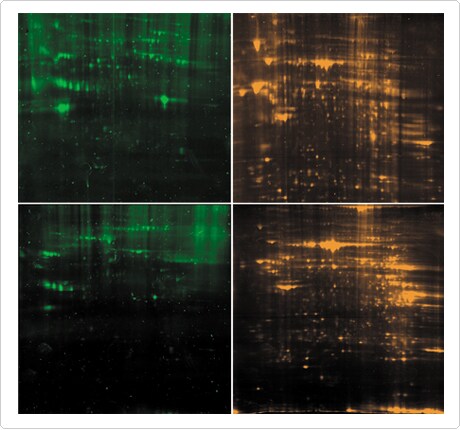Search
Page Contents
For decades, polyacrylamide gel electrophoresis and related blotting techniques have formed the core technologies for protein analysis. Traditionally, these technologies have been paired with chromogenic dye–based protein detection techniques, such as silver or Coomassie brilliant blue staining. With the rapid growth of proteomics,![]() however, the limitations and experimental disadvantages of absorption-based detection technologies and labor-intensive silver staining techniques have become glaringly apparent. The field of proteomics requires new, highly quantitative electrophoresis and blotting techniques that can interface seamlessly with improved microanalysis methods and that can perform in an increasingly high-throughput environment. These requirements are particularly important for quantitative proteomics and multiplexing techniques.
however, the limitations and experimental disadvantages of absorption-based detection technologies and labor-intensive silver staining techniques have become glaringly apparent. The field of proteomics requires new, highly quantitative electrophoresis and blotting techniques that can interface seamlessly with improved microanalysis methods and that can perform in an increasingly high-throughput environment. These requirements are particularly important for quantitative proteomics and multiplexing techniques.
Fluorescence- or luminescence-based detection technologies offer the opportunity for multicolor labeling, making multiplexed analysis possible (Figure 9.1.1). In particular, Molecular Probes fluorescent and luminescent protein stains enable the identification of specific protein modifications (for example, phosphorylation, glycosylation and epitope tags) within the context of the entire protein profile. Simultaneous measurement of several variables greatly increases the amount of data that can be collected in a single experiment. In addition, directly comparing multiple measurements leads to more controlled experiments, more accurate data and fewer ambiguities. The detection characteristics of our protein stains greatly streamline protocols for proteome analysis and promise to bring to proteomics the same capability for rapid, large-scale data acquisition that fluorescence has brought to genomics and other fields.

Figure 9.1.1 Two-dimensional protein gels of tumor versus normal cells stained for glycoproteins and total proteins. Lysates from rat liver tumor cells (top panels) or rat normal liver cells (bottom panels) were run on identical 2D gels. Following electrophoresis, the gels were stained with the Pro-Q Emerald 300 glycoprotein detection reagent (left panels) (available in the Pro-Q Emerald 300 Kits P21855 and P21857). After documentation of the fluorescence signal, the gel was stained with the SYPRO Ruby protein gel stain (right panels) (S12000, S12001, S21900).
We are meeting the demands of the rapidly expanding field of proteomics through the development of fluorescence- and luminescence-based detection methods for proteins in solutions and on gels, blots and microarrays. We are continuing to develop new reagents and detection methods for proteins and their modifications, such as phosphorylation, glycosylation and epitope tags, as well as improved methods of separating and analyzing peptides and proteins. Our advanced technologies are compatible with modern needs for sensitivity, specificity, sequencing compatibility and automatability. Application of our unique detection reagents requires minimal investment in labor, as compared with older technologies, while significantly increasing throughput, reducing total cost and improving accuracy. Furthermore, the greater sensitivity and linearity of most of our premier reagents makes it possible to do quantitative proteomics and perform comparative protein expression measurements on very small samples.
In this chapter, Protein Quantitation in Solution—Section 9.2 includes Molecular Probes reagents and kits (including the Qubit, Quant-iT, NanoOrange, CBQCA and EZQ reagents) for quantitating total protein in solution. Protein Detection on Gels, Blots and Arrays—Section 9.3 includes the important SYPRO stains for detecting and quantitating total protein on gels and blots. Reagents for the qualitative and quantiative detection of phosphorylation, glycosylation and other post-translational modifications are described in Detecting Protein Modifications—Section 9.4 and include:
- Click-iT reagents for detecting nascent protein synthesis, as well as post-translational modifications
- Pro-Q Diamond phosphoprotein gel and blot stains—a breakthrough technology for selectively detecting phosphoproteins in gels and on blots
- Pro-Q Emerald 300 and Pro-Q Emerald 488 glycoprotein gel and blot stains—effective and easy-to-use stains for detecting periodate-oxidized glycoproteins in gels and on blots
Peptide Analysis, Sequencing and Synthesis—Section 9.5 describes reagents used in the synthesis of fluorophore- or hapten-labeled peptides and fluorogenic protease substrates, as well as in peptide analysis and sequencing.
For Research Use Only. Not for use in diagnostic procedures.